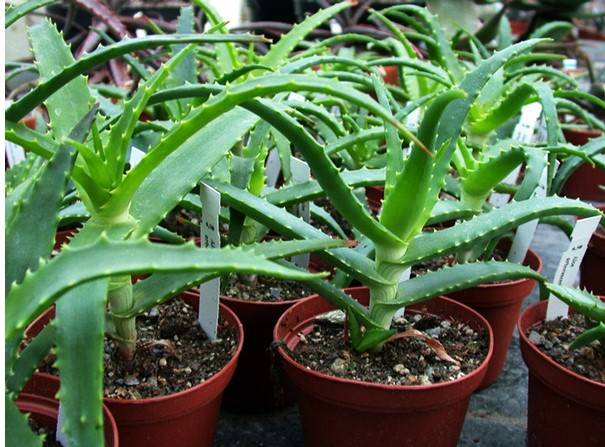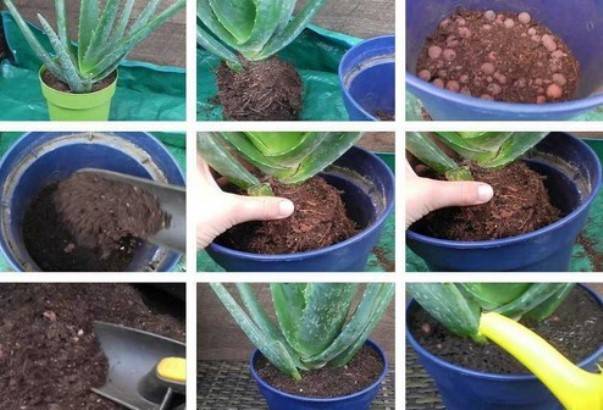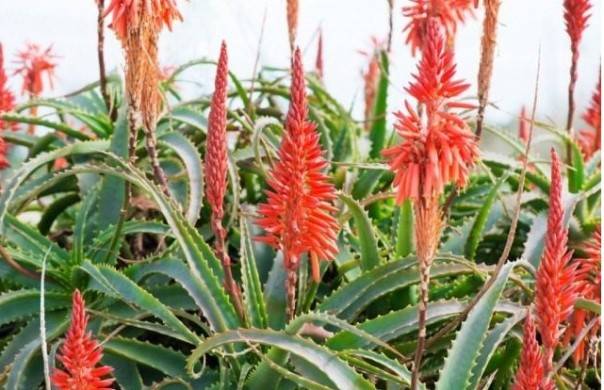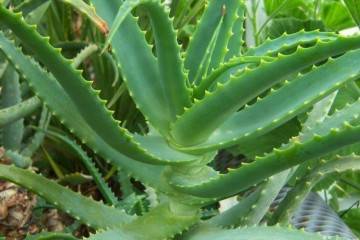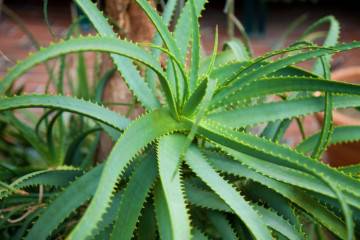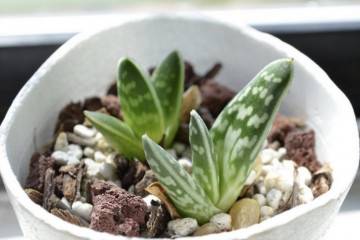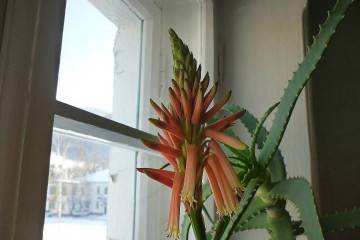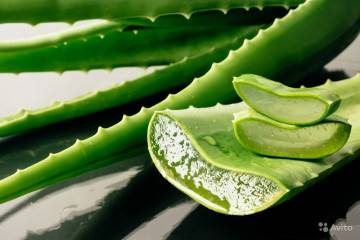Aloe vera - what is it, what a plant looks like
Content:
Since ancient times, people have grown plants not only for food, but also for medicinal purposes. Aloe vera is one of the cultures that was appreciated several thousand years ago and began to use its properties for treatment. This flower began to be cultivated in Africa, and now it grows successfully on the windowsills of apartments in the middle climatic zone.
Aloe vera - what kind of flower is it, why is it called so
Translated from Latin, the name of the flower means "real aloe." Aloe vera is one of the species of the genus Aloe, which means "bitter" in Arabic. This is due to the fact that the leaves of the culture contain a bitter sap.
A short description of what Aloe vera looks like
The plant is a dense bush up to 60 cm in height with fleshy narrow leaves of a light green color, along the edges of which there are notches. The bush is located on a short stem, which can be invisible in a pot. It is a succulent - a species close to cacti, which are able to accumulate moisture in the leaves and go without water for a long time.
Due to the content of many useful substances, aloe vera is used in medicine, perfumery, and cosmetology. Plantations of this flower occupy large areas in countries with favorable climates for its cultivation. This species has settled in apartments for a long time, it differs from its wild-growing counterpart - it is smaller in size.
What distinguishes it from an agave
Many people confuse agave and aloe, what is the difference, the shape of the bush and the medicinal properties of these species will help to understand.
The centenary has the appearance of a small tree with a straight trunk and narrow toothed leaves extending from it. In nature, it can reach a height of 5 meters; in apartments, the dimensions are much smaller. It is used to heal external wounds. Is of South African origin
Aloe vera is a compact bush that can be distinguished from an agave by the color of its leaves. In aloe, they are brighter in color and larger. The substances that make up the juice are used for therapy. The homeland of the flower is North and East Africa.
Medicinal and useful properties
It is difficult to find a plant richer in nutrients - there are more than 200 of them in this culture. Aloe vera contains a group of such components:
- essential oils,
- vitamins of group B, A, C, E, beta-carotene,
- organic acids,
- phytoncides and flavadoids,
- tannins and resins,
- amino acids,
- poly- and monosaccharides,
- trace elements.
For the preparation of medicines, both in folk and traditional medicine, fresh juice from the cut leaves of the plant is used. The form of the drug is in the form of a syrup, ointment, gel, tincture, drop, solution for intramuscular injection.
The components of aloe vera have bactericidal, antiviral properties, remove toxins from the body, support the intestinal microflora, lower blood cholesterol levels, improve blood circulation, and treat gynecological diseases.
Caring for a potted plant at home
In warm countries, the plant is grown in the open air. However, in the strip with cold winters and short sunny days, there are many who want to grow this flower. For many, agave and aloe vera grow at home in a pot.
Illumination and temperature conditions
The southern flower needs good lighting. Access to light guarantees the constant growth of the fleshy, juicy leaves. Aloe vera pots should be on the south side of the room. In the summer, it is recommended to take the pot out to the balcony so that the flower receives more ultraviolet radiation. In winter, the bush is additionally illuminated with a lamp. Due to the lack of light, the plant stretches and fades.
For the winter, the succulent goes into a dormant state. He is transferred to a room with a temperature of about +14 degrees. The plant owner should avoid drafts in this room.
Young shoots need to be shaded so that the bright sun does not burn the leaves, as they grow, they add lighting.
Watering rules and humidity
The flower does not like excess moisture, watering should be moderate, as the soil dries. There must be good drainage at the bottom of the pot to ensure good aeration of the soil. In winter, the volume of water for irrigation should be 2 times less than in summer, more frequent leaving will not be beneficial.
From March to September, water is watered 1-2 times a week, depending on the rate of drying of the earth. During the rest period, no more than 1 time per month, periodically loosening the soil.
Sword-shaped leaves should be moistened by wiping with a damp cloth. It is not worth sprinkling the plant from a shower or sprayer. This can lead to stagnation of moisture at the base of the growth of the sheets. If water gets into the sockets of the inflorescence, it must be removed from there.
Top dressing and soil quality
Aloe vera is fed in the summer, in winter the plant is at rest. Fertilized with minerals once a month from April to September. You can also feed with complex fertilizer for cacti.
The culture prefers cactus soil, which can be purchased at a garden store. It can also be called as a substrate for succulents. But you can prepare the ground yourself. To do this, mix 40% of ordinary earth, 30% of light soil, 15% of sand and 15% of humus. As a result, you need to get a slightly acidic earth (if necessary, it is deoxidized with ash).
Flower container size
It is better to take a clay pot for a succulent, it does not heat up in the sun and will allow the bush to grow freely. It is better to take a container that is elongated in width. This will make the massive bush more stable and prevent it from falling on its side.
After the plant has a dense root part, it must be transplanted into a pot 20% larger than the previous one. Otherwise, the bush will not be able to receive sufficient nutrition from the depleted soil, the roots will not be ventilated.
Pruning and replanting
Periodically, rejuvenating pruning is carried out, old and damaged leaves, peduncles are removed after the flowers have fallen. The elongated leaves are pinched to form a compact, squat bush. An unkempt flower will look unsightly, taking nutrients into old leaves.
If the crown is already 2 times larger than the container in which it grows, you can safely transplant aloe. The transplant is done often, since the bush is growing quite actively. Young plants are transplanted annually because the root system forms quickly and pot space may not be enough. An adult formed bush is transplanted every 3 years.
The new container should be 1/5 larger than the previous one.
The bottom of the pot is laid out 2 cm with drainage, which can be expanded clay, pebbles, charcoal.Half of the container is covered with prepared enriched soil and a bush is planted in it. Pour the pot up to the top with earth, water the plant.
Flowering and dormant period of aloe vera
Blooming aloe vera in home walls is not easy to achieve. It is necessary to create favorable conditions - a warm room and good access to light. They begin to cook the tree in winter, leaving it in the cold at temperatures up to +14 degrees. In April, they are taken out to a sunny warm place, actively fertilized. Aloe blooms throughout the summer season, after the flowers have shattered, the peduncle must be removed so that it does not draw juices from the plant.
The main care is in the summer, when the plant is actively developing. In winter, aloe vera is left alone - they do not carry out transplants, dressings, watered once a month. The bush should be in a cool room with good lighting.
Reproduction of Barbados aloe
Barbados scarlet and scarlet vera are one and the same plant. The culture received the second name for the halo of habitation on the island of Barbados. It's easy to grow it at home, but you need to know some subtleties. The breeding process deserves special attention.
Cuttings
In the spring-summer period, a strong stalk is cut, growing from the point of growth or from the main stem. They are put on germination in clean water. After the roots appear, they are planted in a pot with prepared soil, watering in the first months is minimal. Aloe needs to be given time for root development and adaptation.
Growing from seeds
Seeds are planted in moist soil treated with pests and bacteria to a depth of 1 cm. Cover with foil until shoots appear. Young bushes develop together for several months, then they are planted in a separate container.
Growing problems, diseases and pests
Despite the fact that aloe vera is an unpretentious plant, there are frequent cases of disease and death of the flower.
Aloe vera is loved by all kinds of pests - aphids, scale insects, mealybugs. Insecticides are used against them. Handy methods of dealing with insects are the processing of sheets with a solution of laundry soap and garlic.
Dry rot disease may not manifest itself for a long time, then the stem begins to dry out. The disease can be prevented by organizing good drainage of the flower.
Abundant watering with cold water leads to root rot. To save the plant, they dig it up, dry the root part, treat it with ash.
If the leaves turn yellow or wither, most likely, the plant is regularly poured - it is necessary to reduce watering. The reddish shade of the crown indicates the oversaturation of the flower with sunlight. Aloe is placed in a darker place or shaded with a screen made of fabric, paper.
Aloe vera is a culture that will delight you with its exotic look all year round. An unpretentious plant can be grown even by beginners, flower growers without any experience. If you properly care for it, observe the temperature regime, the succulent will live for many years and become a home medicine cabinet due to its antibacterial, immunostimulating properties. The ability to treat various ailments is a hallmark of aloe vera. This is why it is so popular on apartment windowsills.

